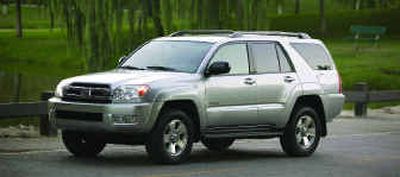4Runner: Few rigs do so much so well

Whenever I test a Toyota 4Runner, I have to fight the urge to go find a hilly, log-strewn trail, a track scattered with way-blocking boulders and deep pools of tire-sucking, quicksand-grade mud.
It’s Toyota’s fault. If they didn’t want me to abuse their 4Runner they should have turned it into a car-based crossover whose highest purpose is to provide safe passage on wintry roads.
But Toyota plugged that hole in 2001 with the Highlander and now they’re free to pursue a market segment all but spurned by the rest of the industry, drivers who need reliable, competent and comfortable transportation in difficult conditions.
The SUV class may stumble in the face of rising fuel costs, but there will always be a need for a rig that won’t let you down when the going gets tough.
The 2005 4Runner is the fourth-generation of a lineage that dates back to 1985. It received its most recent makeover in 2003, when it grew by a few inches in length and width, gained an optional V-8 and got fully boxed side-rails, which stiffened the overall structure and improved the ride.
In ‘04, the 4Runner sprouted third-row seating, and this year its optional, 4.2-liter V-8 got a power bump; it’s now rated at 270 horsepower and 330 pound-feet of torque. Additionally, the base V-6 is paired with a new, five-speed automatic transmission, replacing last year’s four-speed gearbox.
But where the 4Runner has separated itself from the competition is in the amount of content devoted exclusively to serious off-roading.
In even its base SR5 form (from $28,360, including destination), the 4Runner is equipped with some nifty technologies, including Hill-Start Control, which prevents the 4Runner from rolling backward or twisting sideways when accelerating from a dead stop up a steep hillside.
The four-wheel drive systems vary somewhat between six- and eight-cylinder models. In the six, a system called Multi-Mode allows the driver to choose between 2WD and 4WD via a dashboard selector; unlike some part-time 4WD systems, Multi-Mode allows engagement of 4WD on dry pavement without doing damage.
The eights utilize full-time 4WD that automatically apportions power to the wheels with the most traction.
All 4WD 4Runners feature locking center differentials and two-speed transfer cases with a low range for creeping up and down extreme slopes. A feature called Downhill Assist Control (DAC) provides added security during steep descents by automatically holding the 4Runner to a target speed.
Further underscoring this go-anywhere ethic is Toyota’s decision to equip all 4Runners — even 2WD versions — with skid plates to protect the engine and fuel tank. Four-wheel-drive models add a third for the transfer case.
All 2WD models are equipped with a limited-slip rear differential that makes them as capable off-road as some AWD sport-utes; hence the need for underbody protection.
Also standard are electronic traction-control and an anti-lock braking system with electronic brake-force distribution and brake assist. The ABS system even includes a special off-road algorithm that improves stopping performance in slippery conditions. In the past, off-roaders have had to disable ABS because it was incompatible with serious stump-jumping.
As long as we’re talking systems, we should mention the optional air suspension system, which automatically adjusts ride height according to vehicle load, including a tow-load. It also can be manually activated to elevate the rear suspension for increased ground clearance.
The air suspension can be teamed with a deceptively simple system called X-REAS, for “diagonal-linked (picture an ‘X’) relative absorber sport enhanced suspension system.” Developed by Yamaha, X-REAS links the shock absorbers diagonally (right front to left rear, etc.) through hydraulic lines and a central control unit to reduce body roll and pitch. The result is a controlled, level ride through corners and on rough surfaces.
Life is all about compromise, of course, and so is automobile design. Independent rear suspensions (in which each wheel is free to react to road-surface irregularities independent of the other) are generally preferred because they provide superior ride comfort. However, Toyota continues to use a solid rear axle because it allows more suspension travel, enhancing both comfort and performance off-road.
In terms of the rest of the package, the 4Runner is a mixed bag. Its interior is quiet, understated and well laid out and the switchgear has a satisfying heft and feel typical of the company’s offerings. The materials are attractive and of apparent quality; fit and finish is impressive.
Automatic climate control is standard across the line and the controls are large and easy to decipher and use. The gauges are housed in deep binnacles but sometimes wash out in bright sunlight.
Front-seat occupants sit low to the floor, with their legs stretched out ahead and the low roofline may present problems for some taller drivers. The steering wheel tilts and telescopes, making it easy to find a comfortable driving position.
Despite the recent growth spurt, second- and third-row seating (a pair of jump seats that fold down from the cargo-area wall) is cramped, although adults will be comfortable in the second row.
The rear seats fold down to yield 72.1 cubic feet of cargo space, although the third-row seats must be removed for maximum room. An optional tiered storage system allows two levels of storage. Tie-down hooks dot the floor and sides.
The 4Runner does not answer all needs. However, buyers who need more from their transportation than a pretty face and a pleasing personality will do well to include it on their shopping list. Few vehicles on the road today can claim to do as much as well as the 4Runner.